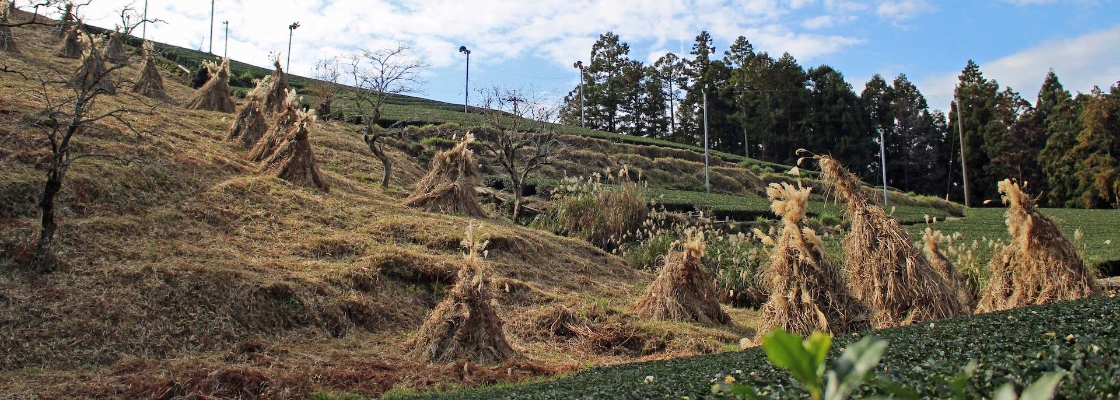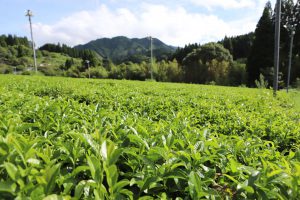Globally Important Agricultural Heritage Systems (GIAHS) related to tea

MENU
Name of System: Takachihogo-Shiibayama Mountainous Agriculture and Forestry System
高千穗乡-椎叶山的山间土地农林业复合系统
Area: Miyazaki Prefecture, Japan
Date of recognition: 15 December 2015
A wide variety of agriculture and forestry maintain the environment
Takachihogo and Shiibayama regions (Takachiho Town, Hinokage Town, Gokase Town, Morotsuka Village, and Shiiba Village) are steep mountainous areas surrounded by forests with little flat land.
In the harsh environment of mountainous areas, the local people have established a composite management system of agriculture and forestry. The system combines timber production and various agriculture (shiitake mushroom cultivation using broad-leaf trees, terraced rice growing, beef cattle raising, tea cultivation, etc.). Thanks to the system, the people have made a living without using up excess forest through timber harvesting and reclamation.
Conifers such as Japanese Cedar and Hinoki Cypress, used for timber production, deciduous broadleaf trees such as Sawtooth Oak, used in shiitake mushroom cultivation, and evergreen broadleaf trees can be seen spreading out in a unique patchwork pattern across the mountains.
The complex agricultural and forestry system, including the tea cultivation in this area, was recognized as a Globally Important Agricultural Heritage System (GHIAS) by the Food and Agriculture Organization of the United Nations (FAO) in 2015.
Sustainable burn farming
In this region, slash-and-burn farming has been conducted in relatively small sites. Crops are cultivated at the sites for the following four years. After four years, the site will be left fallow for about 20 to 30 years. Once the site’s fertility recovers, this shifting cultivation cycle starts again. Because of the cycle, sustainable agriculture can be conducted.
Biodiversity in the forest
By cutting weeds and bushes, thinning trees, etc. rare plants and animals can continue to live and biodiversity is maintained in the forests.

Traditional kamairicha (pan-fired tea)
Takachihogo and Shiibayama regions are some of the few kamairicha production places in Japan. Kamairicha is pan-fired green tea.
Kamairicha has long been made using wild tea in mountainous areas.
The kamairicha leaves are twisted into a rounded shape because the tea leaves are not formed by a machine as with sencha (steamed green tea). Kamairicha has a rich aroma and refreshing flavor.
Because this area is high in altitude and pests are less likely to thrive, many teas are cultivated without pesticides.

Rice terraces and mountainside irrigation canal
Despite being a mountainous site with little arable land, about 1,800 hectares of terraced rice fields are created. A 500km canal network has been constructed on the mountainous site. The canal not only irrigates water to the rice fields but also drains rainwater and protects the region from natural disasters.
The tie of the local community and traditional culture
Traditional cultural events such as kagura (ancient Shinto music and dancing) have been passed down through generations.
The ties of the local community strengthen through such events, and people cooperate with each other to carry out agriculture and forestry in the harsh natural environment.

Tea related facilities:
Reference:
The Food and Agriculture Organization (FAO), GIAHS Globally Important Agricultural Heritage System
http://www.fao.org/giahs/en/
FAO, GIAHS Globally Important Agricultural Heritage System, Takachihogo-Shiibayama Mountainous Agriculture and Forestry System, Japan
https://www.fao.org/giahs/giahs-around-the-world/japan-takachihogo-system/en
農林水産省HP、世界農業遺産 Globally Important Agricultural Heritage Systems (GHIAS)
https://www.maff.go.jp/j/nousin/kantai/giahs_1_1.html
世界農業遺産高千穂郷・椎葉山地域 https://takachihogo-shiibayama-giahs.com
リーフレット、世界農業遺産、高千穂郷、椎葉山地域 発行:宮崎県
*The information provided on this site may be updated. If you find any information in this article that is incorrect, new, or incomplete, please contact CHAMART.
#GIAHS #miyazaki